Having lived in Japan for almost 8 years, many people ask me if I miss Japanese food. And truth be told, I do, but my answer is not always what they expect. As an Irishman with a very sweet tooth (and indifference about most seafood), I don’t so much miss the Sushi bars as the chocolate bars!
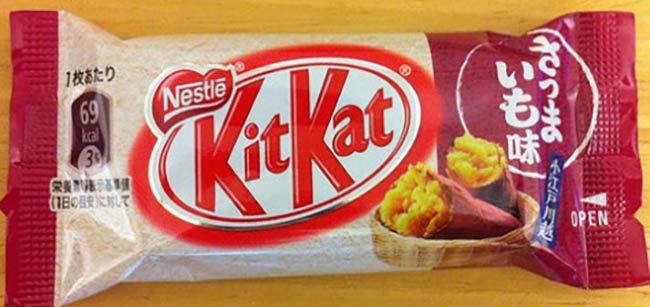
Kit Kat’s Sweet Potato Flavoured Bar (above)
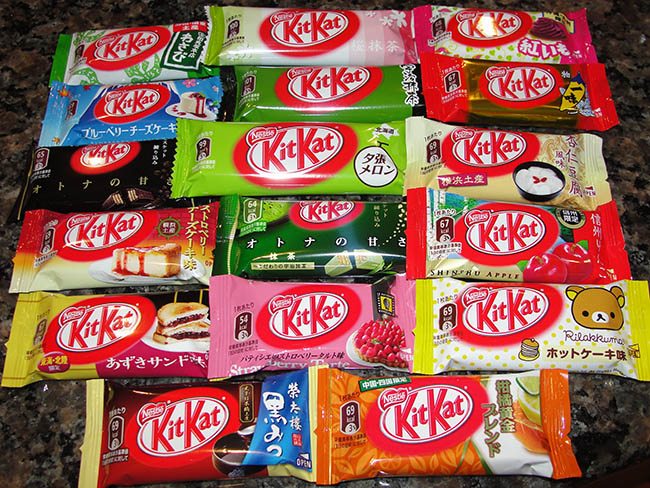
Nestle’s first product adoption for the Japanese market was green tea flavoured bars, as they wanted something for Japanese people to eat when drinking their favourite soft beverage.
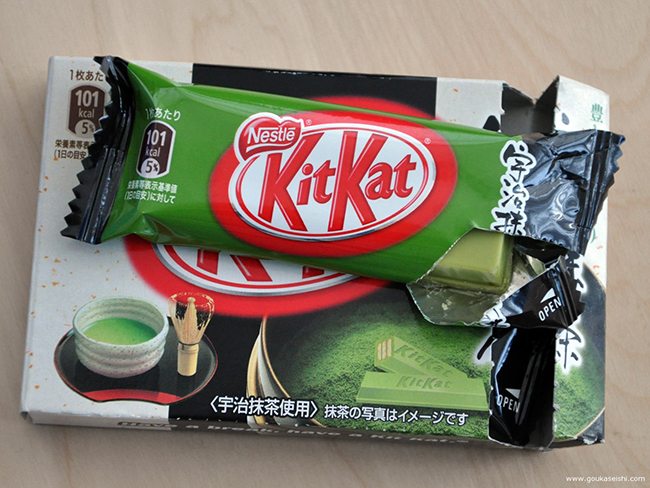
Over the years, countless more variations of this classic Japanese flavour have been launched in Japan.
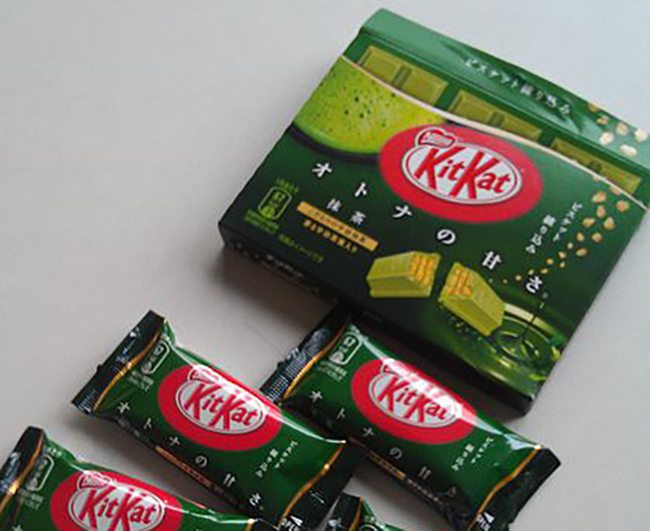
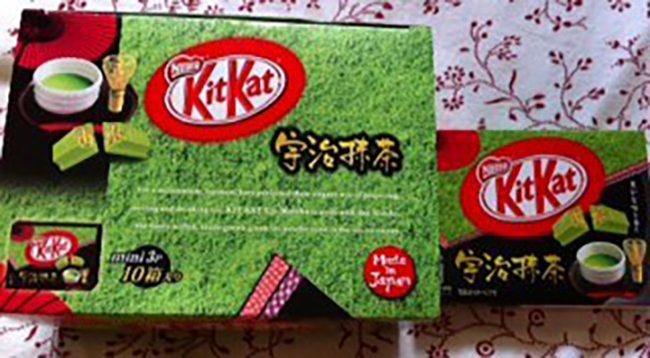
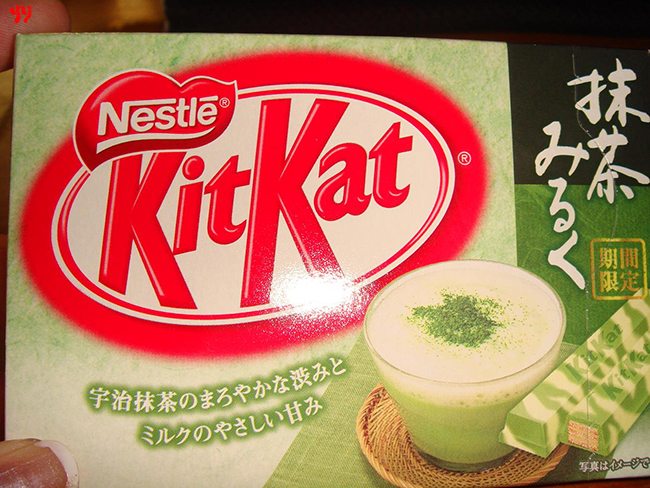
My favourite of which is either the Green Tea with Milk flavoured bar above or the below Sakura (Cherry Blossom) flavoured Maccha (green tea) Latte.
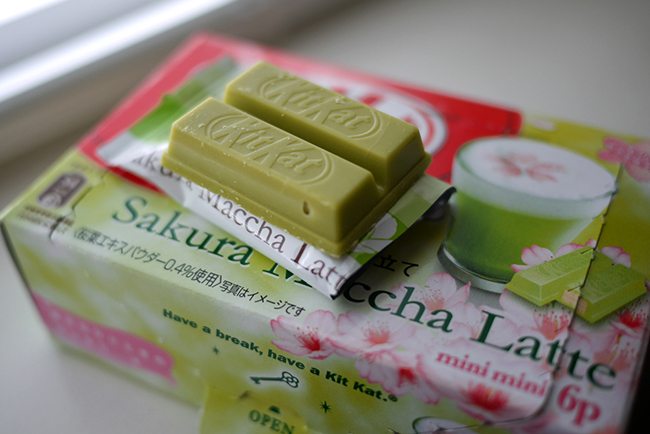
Of course, other varieties of Tea were not excluded from getting their own Kit Kat bar.
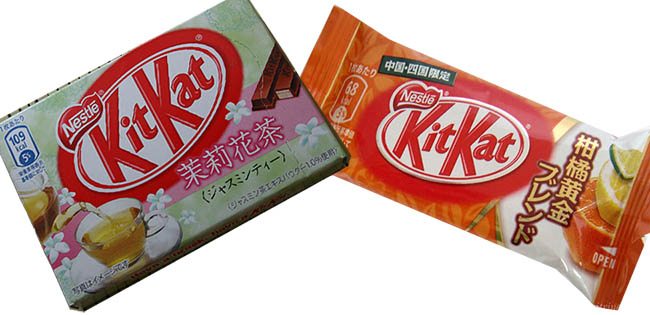
Above are a Jasmine tea flavoured bar (left) and “Hojicha Roasted Tea Citrus Golden Blend” flavoured bar.
In 2012, Nestle’s Kit Kat overtook long standing market leader Meji to become the best selling chocolate bar in Japan. But their rise to success was an interesting study in strategic marketing. Having entered the Japanese market in 1973, for many years Nestle saw a surge in sales of Kit Kat bars at the start of the year and then a dramatic fall-off sometime in March. This puzzled the marketing heads at Nestle’s headquartered but the reason didn’t become clear for some years.
What transpired is that Kit Kat is a similar pronunciation to Kitto Kattsu (きっと勝つ), translated as “You will surely win,” and could be mailed as a good luck gift for students ahead of university exams. As the academic year begins in April, many entrance exams take place in the first few months of the year. After finally discovering what was going on with sales in Japan, Nestle began selling higher value gift boxes to students during typical cramming periods before state exams.
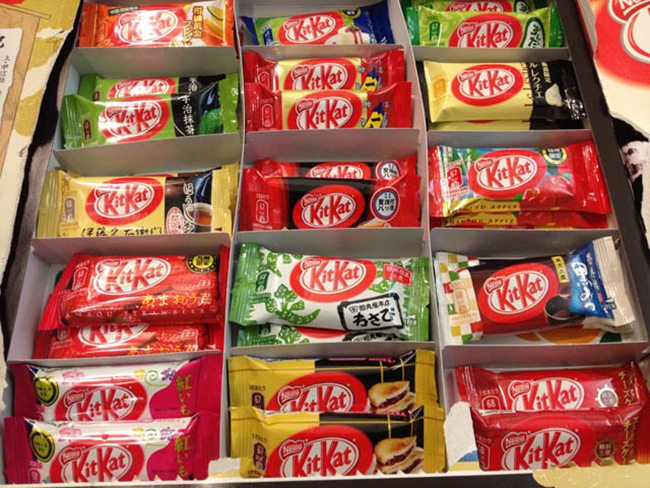
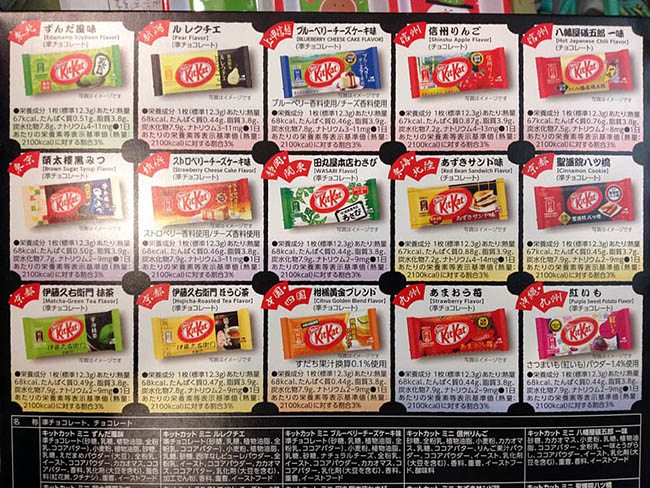
After discovering the route to their success Nestle has really latched onto this emergent marketing strategy (rather than a deliberate planned strategy). Kit Kat’s “Lucky Charm” advertising campaign in Japan won the Asian Brand Marketing Effectiveness Award in 2005 and in 2009 Nestle partnered with Japan Post and launched a campaign in 2009, allowing people to write messages and mail the chocolate bars from 20,000 post offices. The special packages included a space to write a message of encouragement and affix a stamp. The promotional packages were sold out within a month. That campaign won the Media Grand Prix at 2010’s Cannes Lions International Advertising Festival.
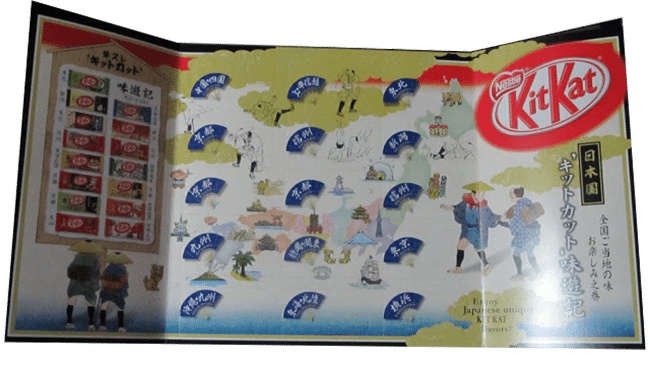 Further more, Kit Kat found that Japanese convenience store, most of which are hard pressed for space, frequently rotated product off their shelves to test appetites for new items and to keep customers engaged and interested to come back into their store. By producing smaller batches of unique flavours, often with a seasonal twist, Nestle managed to secure their shelf listing permanently in most store. It was economically viable in Japan as there is no culture of charging an initial product listing fee like in many western countries.
Further more, Kit Kat found that Japanese convenience store, most of which are hard pressed for space, frequently rotated product off their shelves to test appetites for new items and to keep customers engaged and interested to come back into their store. By producing smaller batches of unique flavours, often with a seasonal twist, Nestle managed to secure their shelf listing permanently in most store. It was economically viable in Japan as there is no culture of charging an initial product listing fee like in many western countries.
![]()
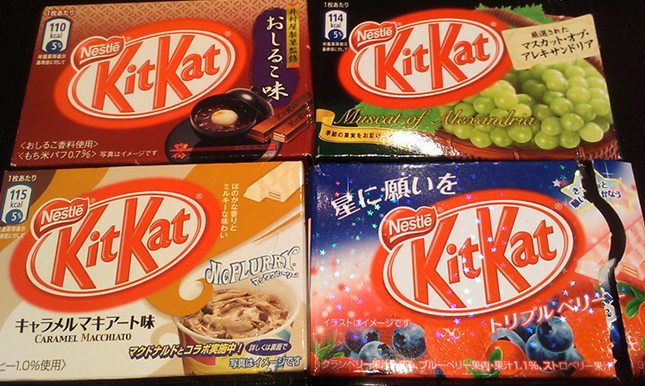
Japanese culture places a huge significance on recognising, marking and celebrating the changing seasons in Japan. To capitalise on the ceremonial nature of how Japanese people like to celebrate the arrival of different seasons with each other, Kit Kat reflects these commonly held Japanese values and introduces seasonal flavoured items to correspond with the national mood. In fact, it becomes an “event” when the first packaging of the new season is spotted in convenience stores and is widely shared on social media with pride. The company also noted that limited-edition seasonal models created a “scarcity and rarity of value” for customers.
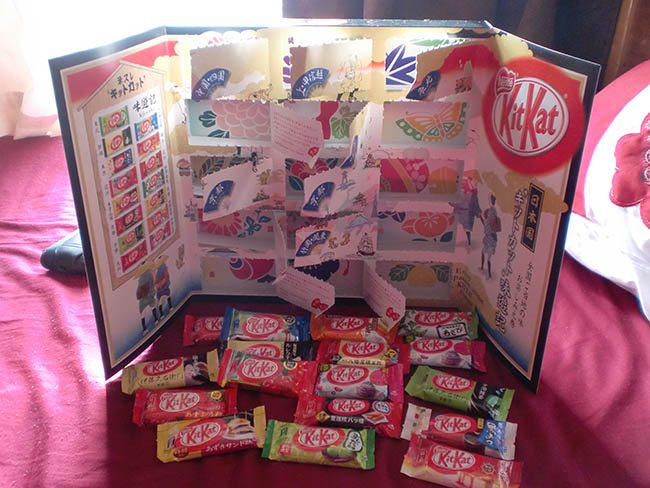
Cherry Blossom branded selection boxes; the perfect item to bring along to Hanami (Cherry Blossom Viewing) parties
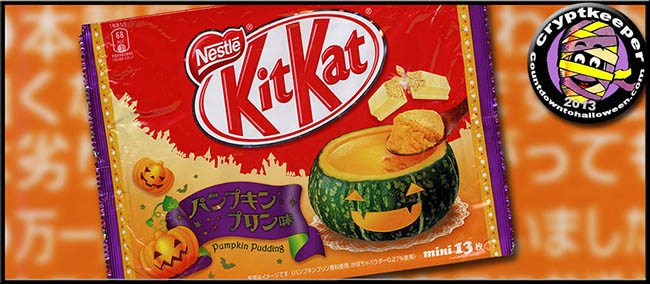
At Halloween. Pumpkin Pie flavoured bars are introduced, each year often a little different.
In Japan, when people travel domestically, there is a strong tradition of bringing back a gift from their travel destination for work colleagues or family members. Kit Kat bars made with flavours associated with regional speciality foods where often a top choice to buy as “omiyage” gifts. The best selling of these was often made available for sale nationwide.
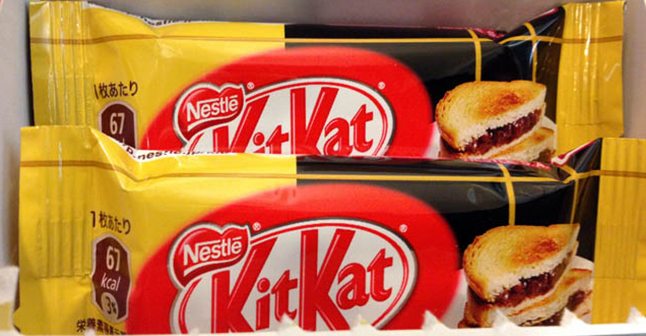
Red Bean Paste Sandwich Flavoured Kit Kat Bars
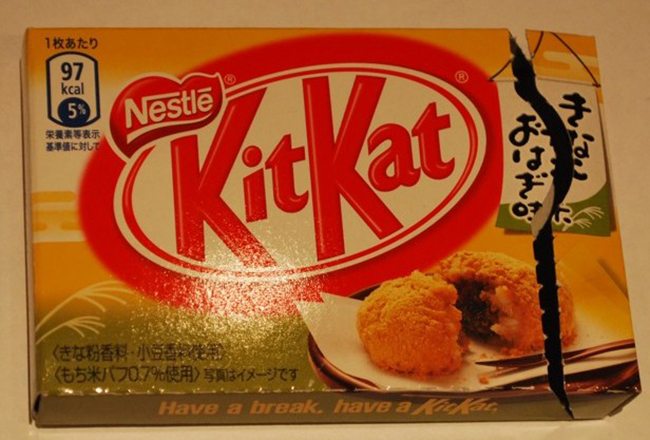
Japanese Rice Ball Flavoured Kit Kat
To date. Nestle has introduced more than 300 unique flavours in the Japanese market and each time a new flavour is introduced the company benefits from the free PR attention that goes with media reports on the new flavour. In recent years, this strategy has paid off with social media shares as people rush to be the first to inform each other of the wackiest new flavours of Kit Kat bars.
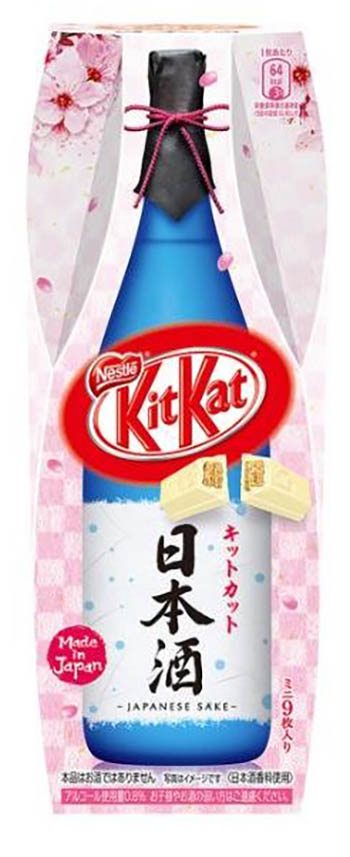
Above is a delicious sake (Japanese rice wine) flavoured kit kat bar!
As evidence of this social media phenomena, this morning a friend of mine shared the below new “Sore Throat Medicine” flavoured Kit Kat on his facebook wall and thus I’m writing this blog post about Kit Kat! This new flavour features a popular ex-soccer coach turned commentator as a celebrity endorsement of the flavour, presumably because he shouts a lot.
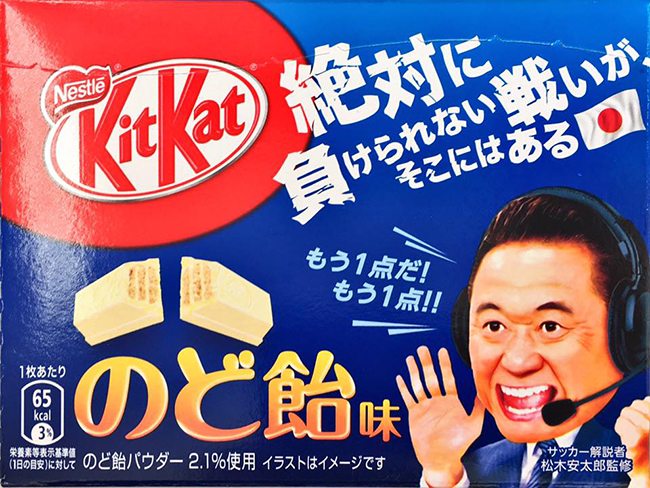
So remember, if you visit Japan, pay close attention to the flavours of Kit Kat bars and you may just find your new favourite chocolate treat!
Other popular flavours have included:
- Apple
- Adzuki (Red bean paste)
- Bakeable custard
- Baked potato
- Banana
- Beni Imo (purple yam)
- Blueberry cheesecake
- Brown sugar syrup
- Cafe au lait
- Cantaloupe (sweet melon)
- Cappuccino
- Caramel Macchiato McFlurry
- Cherry
- Chestnut
- Chocobanana
- Cinnamon cookie
- Citrus golden blend
- Corn
- Cough Drop
- Creme brulee
- Double cookie
- Edamame (soy beans)
- European cheese
- Exotic Tokyo
- Fruit parfait
- Ginger ale
- Golden citrus
- Green bean
- Hojicha
- Hokkaido cheese and chocolate
- Hokkaido Melon with Mascarpone Cheese
- Hokkaido roasted corn
- Hot Japanese chili
- Kinako (roasted soya bean flour)
- Kobe pudding
- Koucha (black tea)
- Kuchidoke Kakao
- Lemon cheesecake
- Maple
- Matcha (green tea)
- Melon and Cheese
- Miso soup
- Muscat of Alexandria
- Okinawa sweet potato
- Passion fruit
- Pear
- Pumpkin
- Ramune (lemonade)
- Raspberry passion fruit
- Red potato
- Rilakkuma hotcake (fictional character’s hotcake)
- Rock salt
- Royal Milk Tea
- Sake
- Sakura (cherry blossom)
- Sakura matcha latte (cherry blossom green tea latte)
- Salt and caramel
- Shikuwasa (flat lemon)
- Shinshu apple (Japanese regional apple)
- Soy flour
- Soy sauce
- Strawberry
- Strawberry cheesecake
- Sweet pudding
- Triple berry swirl
- Vegetable juice
- Wasabi

